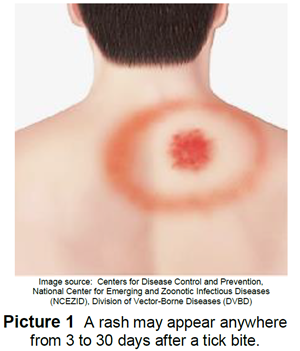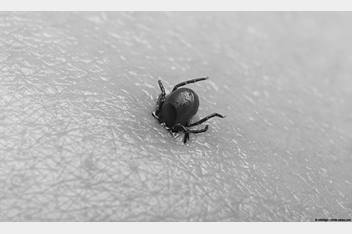Lyme Disease
![]()
Lyme disease is spread to humans through the bite of an infected tick. Not all ticks are infected. The ticks that do carry Lyme disease are tiny and hard to see. They are the size of a sesame seed. Boys, ages 5 to 19, are most at risk for Lyme disease, but anyone can get it.
Signs and Symptoms

- Fever
- Headache
- Chills
- Stiff neck
- Tiredness
- Swollen lymph nodes
- Muscle and joint pain
- Red, growing rash. It may look like a "bulls-eye" (Picture 1).
Treatment
- Check the bite area on your child. Look for a red rash that is growing, looks like a ‘bulls-eye,’ or develops a clear center. Do this every day for the next month. If you see a rash, contact your child’s doctor or health care provider.
- Antibiotic medicine is the main way to treat Lyme disease. It is taken for up to 14 days.
- Your child must finish all the medicine, even if they start feeling better.
- Most people are cured with antibiotics.
- If Lyme disease isn’t treated early, it can spread to the heart, nervous system, and joints. These conditions will require longer antibiotic treatment.
- Your child can return to school or childcare when they feel well enough for daily activities.
Prevention
Tick bites are usually painless. Most people don’t notice when a tick is attached to their skin. Check all family members and pets after being outdoors. Remove all ticks with fine-tipped tweezers. Removal instructions are on Page 3.
When a tick is stuck to the skin for less than 24 hours, the risk of getting Lyme disease is small. Below are ways to help prevent Lyme disease and keep ticks away.
- Wear bug spray (insect repellant).
- DO NOT use a repellant that has sunscreen in it. Sunscreen needs to be applied more often than the repellant.
- Picaridin is an insect repellant that can be used on children over 2 years of age.
- Permethrin spray can be applied to clothing or outdoor equipment like sleeping bags or tents. DO NOT apply to the skin.
- Use insect repellant with 10 to 30% DEET. DEET is an insect repellant that helps repel ticks.
- Do not use DEET on children younger than 2 months of age. Use netting to cover a baby’s seat or play area instead.
- To use DEET:
- Apply to your hands first, then rub it on your child.
- Do not apply over cuts or wounds.
- Do not apply DEET to children's hands.
- The American Academy of Pediatrics recommends that DEET should only be applied 1 time a day.
- Avoid your child's eyes and mouth. Use lightly on ears.
- Do not apply under clothing. If repellant gets on clothing, wash the clothes before they are worn again.
- Keep repellant out of the reach of children and pets.
- After returning indoors, wash your child's skin where DEET was applied or have them take a bath. Wash their clothes with soap and water.
- Control the ticks around your home.
- Ticks are usually picked up on lower legs and crawl up the body seeking a place to feed.
- Ticks do not jump, fly, or drop from trees. They grab onto passing hosts from leaves and grass.
- Wear light-colored clothing with long pants tucked into socks. This makes ticks easier to see and keeps them on the outside of clothes. Wear closed-toed shoes or sandals.
- Pets can bring ticks into the home. This means a person can get a tick bite without being outdoors. Check pets before they come inside. Talk to your vet about ways to protect your pets.
- Ticks live in damp, wooded areas. Around your house should be free of tall grass and leaves. Keep playground equipment, decks, and patios away from wooded areas.
How to Remove a Tick
Wash your hands with soap and water before removing it. To dispose of a live tick: place it in alcohol, place it in a sealed bag/container, wrap it tightly in tape, or flush it down the toilet.

HH-I-289 2/09 Copyright 2009, Revised 4/22 Nationwide Children’s Hospital


